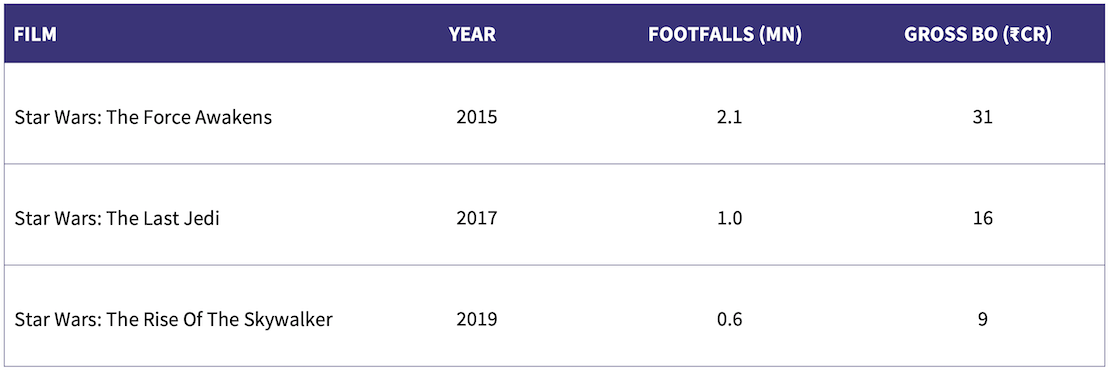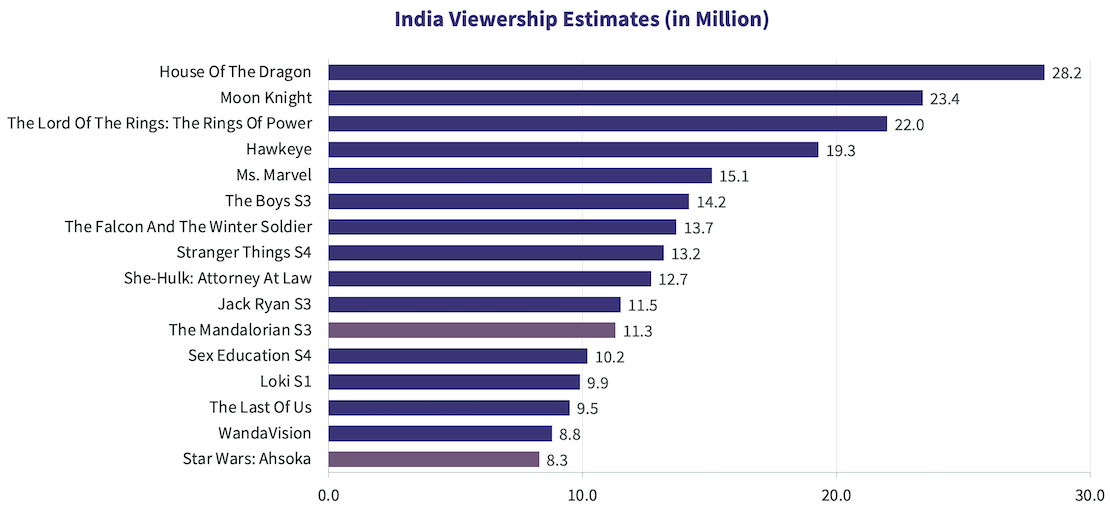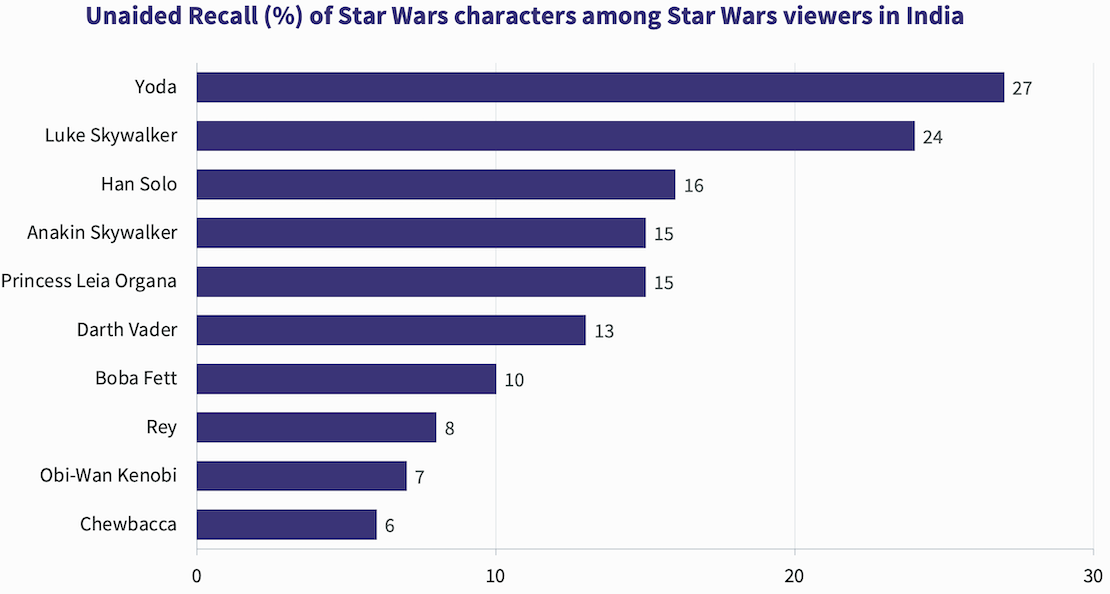


By Shreya Ramakrishnan
Many film followers and analysts in the West consider Star Wars: Episode IV - A New Hope (1977) a turning point in cinema, both from a filmmaking and audience engagement perspective. The success of Star Wars films boosted the confidence of production houses to invest in more science fiction films to meet audience demand, and today, Star Wars references dot the American pop culture landscape. While many international franchises like Marvel and Harry Potter have been able to leverage India as a key market, the fandom of Star Wars remains limited to the West, with little significance in most Asian countries, except Japan, which has generally been ahead of the curve in terms of affinity for science-fiction content. While Hollywood has grown in reach and consumption, Star Wars films have struggled to perform at the Indian box office.
The table below captures the last three Star Wars films’ Box office performance in India:

In contrast to these modest India numbers, Star Wars: The Force Awakens is the highest-grossing film at the US box office of all time, and the fifth highest of all time at the worldwide box office.
The Star Wars franchise has also forayed into shows, with The Mandalorian and the recent Star Wars: Ahsoka. But compared to the fantasy fiction shows that are derived from other franchises (Marvel, Lord Of The Rings, etc.), these shows have relatively underperformed on viewership in India.
The chart below lists some major International series based on their estimated viewership in India. For shows with multiple seasons, the most-watched season has been reported. Viewership of OTT originals is estimated using primary research conducted among audience across India at a weekly level, projected to the OTT universe in India. Our viewership estimates (reported in Million) represents the number of people, in India (not overseas) who watched at least one full episode of the show.

The viewership of both, The Mandalorian and Star Wars: Ahsoka (11.3 Mn & 8.3 Mn respectively) trails behind other fantasy fiction shows like Moon Knight (23.4 Mn), The Lord of The Rings: The Rings of Power (22.0 Mn), Hawkeye (19.3 Mn) and Ms. Marvel (15.1 Mn). Other 2023 international releases like Sex Education S4, The Last of Us, and Jack Ryan S4 have also seen higher viewership numbers than Star Wars: Ahsoka, highlighting a fundamental lack of interest in the Star Wars universe among Hollywood-consuming Indian audiences, despite the franchise’s scale and the rising popularity of fantasy fiction content.
The missing nostalgia
To understand this, it is important to understand what India looked like when the first film released in 1977. Pre-liberalization India was a markedly different place, and 1977 had a country reeling with the after-effects of an Emergency that was withdrawn in March 1977. As a result, the 1970s were a time of strained Indo-US relations, with American companies paying little attention to India as a market. Additionally, India of the 1970s was a poorer market, and going to the theatre itself was a luxury. Coupled with the fact that fewer people understood English (especially accented English) at that time, this made the potential audience for the film very small in number. Dubbing English films into other languages started much later in the 1990s, when Jurassic Park opened up the Hollywood market in India through that route. So, while a clear fandom for the Star Wars universe formed in 1977 in the West, in India no such phenomenon occurred.
Lack of nostalgia alone, however, cannot explain the lack of popularity of the franchise in India, given that four of the films have been released in a post-liberalization India, and audience perspective towards Hollywood content has evolved. Two primary factors have prevented Star Wars from establishing a stronger audience connect in India: the absence of a strategic marketing effort to build the Star Wars fandom in India, and the nature of the content itself.
Sporadic flow of releases
One of the cornerstones of Marvel’s success in India, as well as globally, is the ability to churn out releases consistently. In Phase One, Marvel managed to release six films within four years, focusing on establishing a fandom for Iron Man, Thor, and Captain America. With the fandom for these three superheroes building, Marvel leveraged them to make a crossover film like The Avengers, laying a solid foundation for Phase Two, Three, and Four. The Star Wars franchise wasn’t built with this long-term strategic vision, with sporadic releases separated by many years preventing any audience investment in the franchise. The absence of a long-term strategic perspective on the franchise also impacts other marketing efforts that keep a film alive - like merchandising. Of course, it is easy to now think that Star Wars should have done what Marvel does now, but in the 1970s, we were still 30 years away from thinking of cinema as a global money-minting business. After all, the same Asian countries that are manufacturing powerhouses today, churning out t-shirts, hats, toys, and other Marvel-themed items of our liking, were only infant economies back then.
Content limitations
To date, the American film industry is the only industry that has been able to cater to the growing familiarity and affinity for fantasy films among Indian audience. In such a scenario, you would expect a growth in the Star Wars fandom among those who seek such content. But even among lovers of fantasy, science fiction, and superhero films, the films don’t seem to have found significant resonance in India.
In a recent survey we conducted, viewers of Star Wars (watched at least one film or show) were asked to recall characters from the franchise, at an unaided level. The average number of characters a viewer could recall is only 1.8. Among the top 10 characters recalled, the most recalled character (Yoda) has only 27% recall.

This points towards low engagement with films of the franchise, indicating a possible disconnect with the content itself. Star Wars is a fantasy world, with complicated names, different creatures, and a complex web of relationships and timelines. In comparison, Marvel films are based within our world, with most superheroes being ordinary people who acquire extraordinary powers. However, one could still argue that Marvel films also have a lot of the elements Star Wars has. But there’s one key difference: Marvel films don’t take themselves too seriously. By making the entire universe light-hearted, loud, and colorful, audiences don’t take the films too seriously either. However, Star Wars requires proper investment in the universe and its less vibrant, brown-grey color palette, which inherently restricts it from appealing to the masses. An entire family can enjoy a Marvel film, but the same family is unlikely to enjoy a Star Wars film. This is also why Star Wars fans have always been seen to occupy a ‘geeky’ niche in the pop culture space.
Limited familiarity and popularity of the Star Wars franchise in India is the outcome of a variety of factors, a lot of which are inherent to the content itself. However, the proliferation of global content on Indian OTT, as well as the expansion of the English content consumer base in India post-pandemic, presents Star Wars an opportunity to grow in India. But with aspects of the content themselves being a concern, this might be an uphill task.

India's CTV growth story in numbers
10 key data points from The Ormax OTT Audience Report: 2025, that showcase India's staggering Connected TV (CTV) growth story in numbers

The India Box Office Report: September 2025
Led by They Call Him OG and Jolly LLB 3, September 2025 emerges as another good month at the India Box Office, with gross collections of ₹1,035 Cr

The Ba***ds Of Bollywood: Raising the marketing bar
Ormax Stream Track data reveals that Netflix’s 2025 release The Ba***ds Of Bollywood ranks among the strongest non-franchise streaming launches post-pandemic, second only to Farzi
Subscribe to stay updated with our latest insights
We use cookies to improve your experience on this site. To find out more, read our Privacy Policy